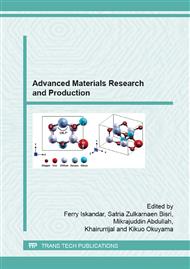p.470
p.474
p.481
p.485
p.489
p.493
p.497
p.502
p.506
The Influence of Calcination Temperature on Quantitative Phase of Hematite from Iron Stone Tanah Laut
Abstract:
This research aims to form particles of hematite (α-Fe2O3) with a basis of mineral iron ore Fe3O4 from Tanah Laut. Magnetite Fe3O4 was synthesized using co-precipitation method. Further characterization using X-ray fluorescence (XRF) to obtain the percentage of the elements, obtained an iron content of 98.51%. Then characterized using thermo-gravimetric analysis and differential scanning calorimetry (TGA-DSC) to determine the calcination temperature, that at a temperature of 445 °C mass decreased by 0.369% due to increase in temperature. Further Characterization of X-ray diffraction (XRD) to determine the phases formed at the calcination temperature variation of 400 °C, 445 °C, 500 °C and 600 °C with a holding time of 5 hours to form a single phase α-Fe2O3 hematite. Testing with a particle size analyzer (PSA) to determine the particle size distribution, where test results indicate that the α-Fe2O3 phase of each having a particle size of 269.7 nm, 332.2 nm, 357.9 nm, 412.2 nm. The best quantity is shown at a temperature of 500 °C to form the hematite phase. This result is used as the calcination procedure to obtain a source of Fe ions in the manufacture of Lithium Ferro Phosphate.
Info:
Periodical:
Pages:
489-492
Citation:
Online since:
July 2015
Authors:
Keywords:
Price:
Сopyright:
© 2015 Trans Tech Publications Ltd. All Rights Reserved
Share:
Citation:


